Nakagawa Hamono
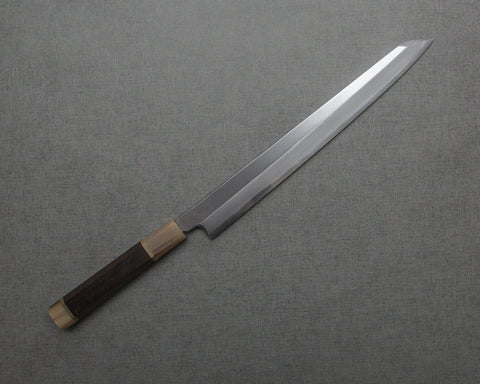
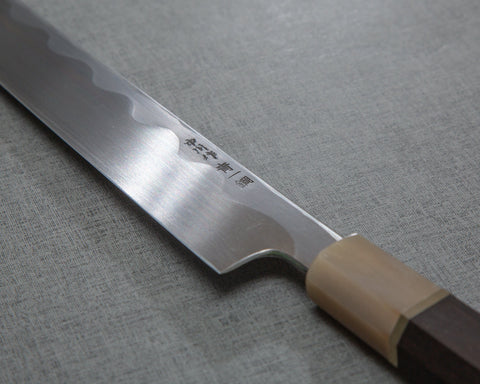
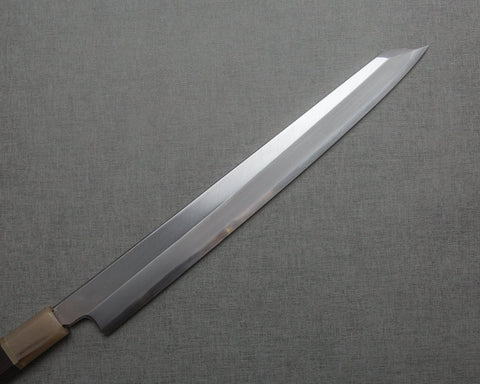
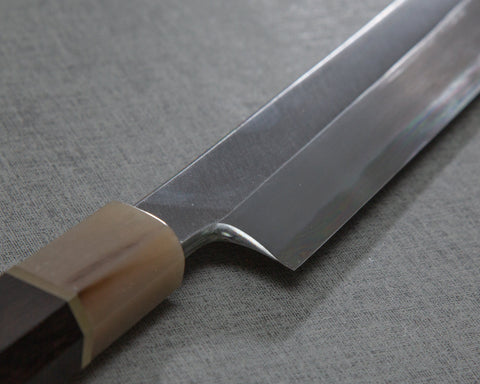
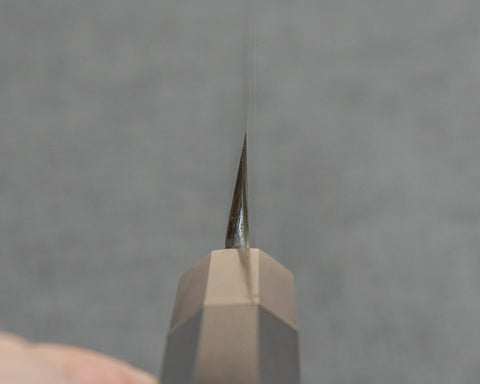
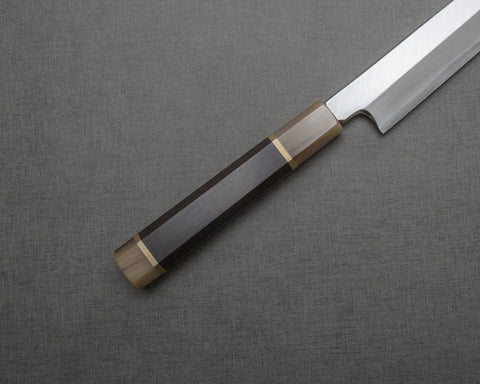
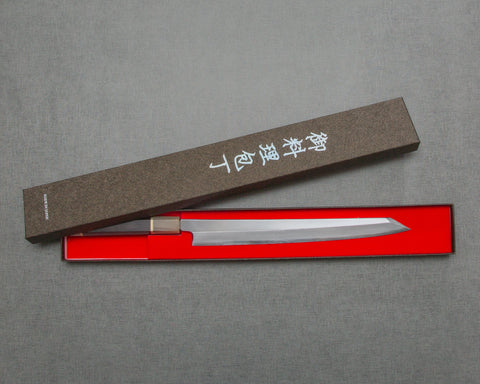
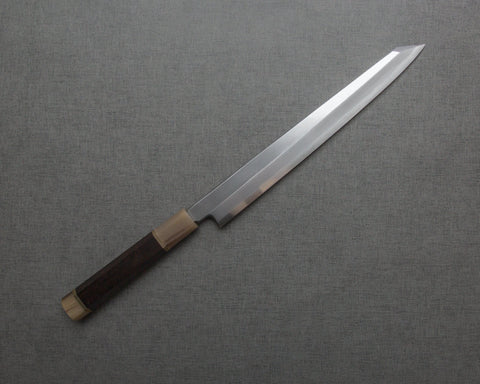
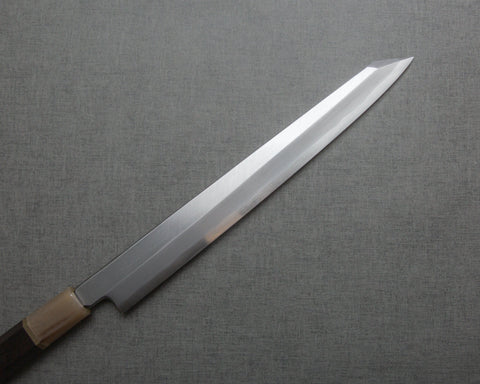
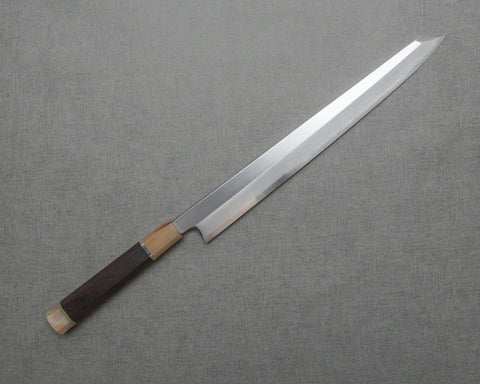
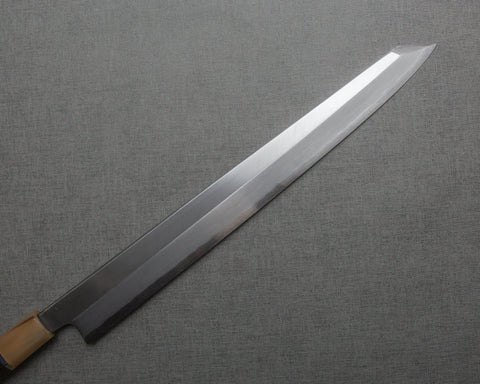
Nakagawa Aogami #1 Kiritsuke Yanagiba
Pickup currently unavailable
This Kiritsuke Yanagiba is handcrafted by Sakai knifemaker Satoshi Nakagawa using Aogami #1 steel core with soft iron cladding. With a higher carbon content than Aogami #2, Nakagawa-san was able to heat-treat the blade to a hardness level of 61-63 HRC, enabling superior edge retention. The blade has very good fit and finish, with the soft iron cladding wrapped around the spine to create an exquisite ripple pattern on the back. Paired with a premium double-ginmaki marble buffalo horn ebony wa-handle.
Spec:
- Origin (Made in): Sakai, Osaka Prefecture, Japan
- Brand: Nakagawa Hamono
- Craftsman: Satoshi Nakagawa
- Knife Type: Kiritsuke Yanagiba
- Blade
- Construction: Awase (Kasumi)
- Grind: Single Bevel (Right-handed)
- Hagane (Core Steel): Aogami #1 (Blue #1)
- Jigane (Cladding): Soft Iron
- Hardness: 61-63 HRC
- Hand-forged, hand-ground, hand-sharpened
- Blade Finishes:
- Kasumi Polish
- Ripple
- Blade Length: 270mm (10.6") / 300mm (11.8") / 330mm (13.0")
- Blade Height (at heel): 33mm / 36mm / 38mm
- Spine Thickness
- Above heel: 4.2mm / 4.6mm / 4.8mm
- Middle: 3.2mm / 3.6mm / 3.9mm
- Handle
- Shape: Hachikaku (Octagonal)
- Material: Ebony
- Kuchiwa / Tsukajiri: Marble Buffalo Horn
- Ginmaki: Nickel Copper (x2)
- Length: 145mm / 145mm / 153mm
- Overall Length: 423mm / 453mm / 491mm
- 252g (8.89oz) / 295g (10.41oz) / 344g (12.13oz)
- Engraved Mark: In Japanese Kanji "Nakagawa Made Blue #1" (中川作 青一鋼)
About Nakagawa Hamono 中川打刃物
Satoshi Nakagawa (中川 悟志) is a relatively young knifemaker based in the famous city of Sakai in Japan. 16 years ago, he started learning from legend artisan Kenichi Shiraki (白木 健一), one of the very best blacksmiths in Japan. As master Shiraki retired and closed his workshop in 2020, the torch has been passed down to Satoshi Nakagawa, Shiraki’s only Deshi (disciple). In April 2021, Satoshi Nakagawa-san launched his own workshop Nakagawa Hamono.
Care:
Aogami #1 (Blue #1) steel is a premium Japanese high carbon steel for knife making. Despite some corrosion resistant quality (for a carbon steel), it is not stainless, therefore you should wipe your knife dry after each use. Patina will develop over time. Rust may develop if left in prolonged contact with water or acidic food. Use a rust eraser to clean if rusts develop. Avoid cutting into bones, frozen foods, hard fruit pits.
Cutting Surface:
Recommended cutting surface: wood, rubberized boards and high-end composites, and quality plastics such as polyethylene make acceptable cutting surfaces, and will help protect and prolong knife’s edge. AVOID glass, metal, countertops, and other rigid, non-forgiving surfaces.
Sharpening:
We recommend sharpening all quality Japanese knives on whetstones, as we believe they yield the best results for your knives.
My only complaint is the handle needs to be refined a bit more. The handle is not smooth.
Free Shipping
Free Shipping on most orders.
30 Days Return
Return unused within 30 days for a full refund, no questions asked (terms apply).
Top Japanese Makers
All knives made in Japan by top Japanese knife makers.
About
Burrfection Store sources professionally designed sharpening products, and knives from top Japanese craftsmen.
